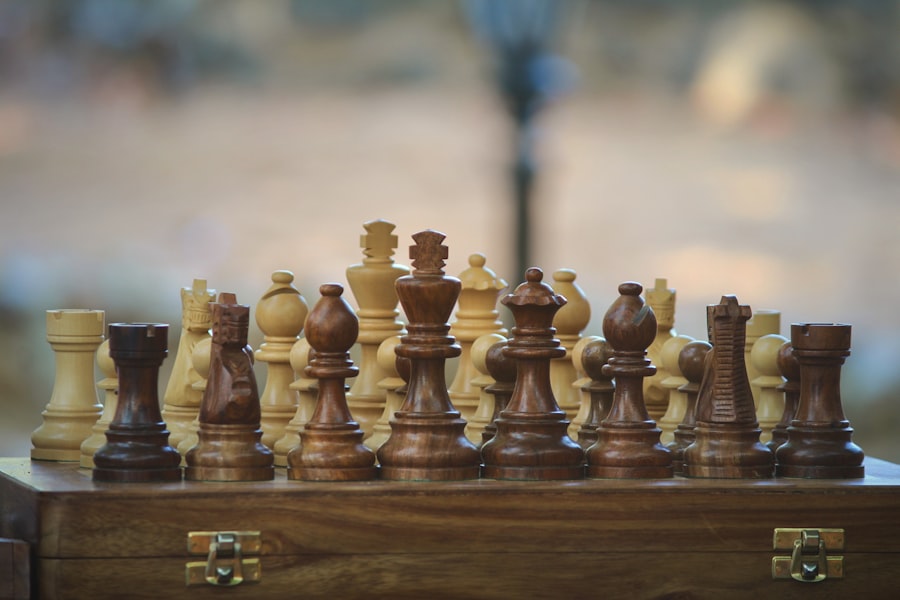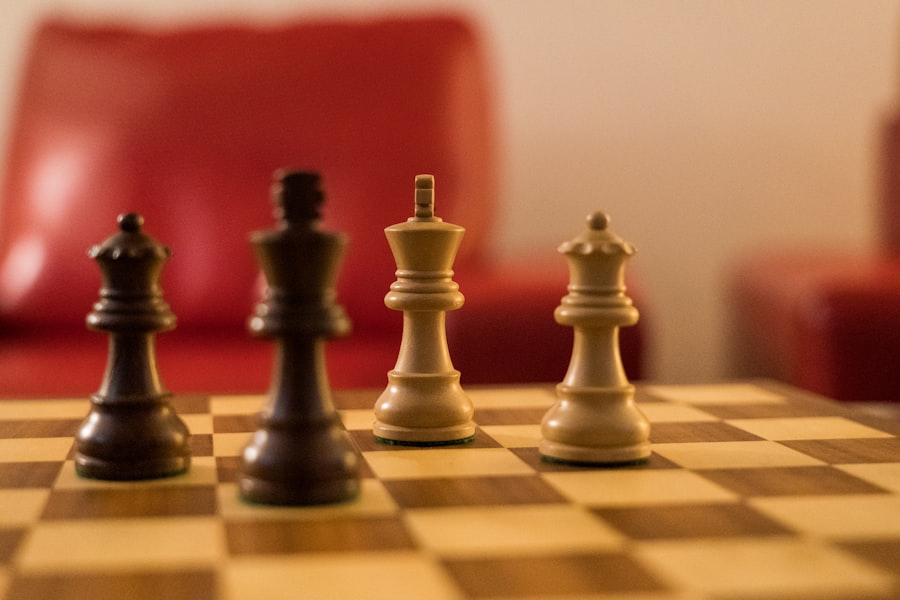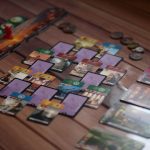Mastering Chess: Strategies for Success
Description
Chess is a two-player strategy board game that has captivated minds for centuries. At its core, the game is played on an 8×8 grid known as a chessboard, where each player commands an army of 16 pieces: one king, one queen, two rooks, two knights, two bishops, and eight pawns. Each piece has its own unique movement rules, which dictate how it can traverse the board.
The objective is straightforward yet profound: to checkmate the opponent’s king, meaning the king is in a position to be captured and cannot escape. The game begins with a specific setup, where pieces are arranged in two rows for each player. The back row typically consists of the more powerful pieces, while the front row is filled with pawns.
Understanding how each piece moves is fundamental to grasping the game.
The queen is the most powerful piece, capable of moving any number of squares in any direction, while the king can only move one square at a time in any direction.
Pawns have a unique movement pattern; they advance one square but capture diagonally, and they can move two squares forward on their first move.
Key Takeaways
- Chess involves two players, each with 16 pieces, aiming to checkmate the opponent’s king.
- A strong opening repertoire involves understanding and mastering various opening moves and their potential outcomes.
- Tactical maneuvers involve short-term moves to gain an advantage, while strategic maneuvers involve long-term planning.
- Improving endgame techniques involves understanding how to use remaining pieces to checkmate the opponent’s king.
- Studying grandmaster games can provide valuable insights into advanced strategies and tactics.
Developing a Strong Opening Repertoire
A well-structured opening repertoire is essential for any chess player aiming to improve their game. The opening phase sets the stage for the middle game and can significantly influence the outcome of the match. Players often choose openings based on their style and preferences, whether they favor aggressive tactics or solid positional play.
Popular openings include the Ruy Lopez, Sicilian Defense, and Queen’s Gambit, each with its own strategic ideas and plans. To develop a strong opening repertoire, players should familiarize themselves with key principles such as controlling the center of the board, developing pieces efficiently, and ensuring king safety through castling. For example, in the Ruy Lopez, White aims to control the center with pawns on e4 and d4 while developing knights and bishops to active squares.
Understanding the main lines and variations within these openings allows players to navigate the early game confidently. Additionally, studying common traps and pitfalls can help avoid early blunders that could lead to a disadvantageous position.
Mastering Tactical and Strategic Maneuvers

Tactics and strategy are the lifeblood of chess, each playing a crucial role in determining the outcome of a game. Tactics refer to short-term calculations that can lead to immediate gains, such as winning material or delivering checkmate. Common tactical motifs include forks, pins, skewers, and discovered attacks. For instance, a knight fork can simultaneously attack two pieces, forcing the opponent to choose which one to save. On the other hand, strategy encompasses long-term planning and positional considerations.
It involves evaluating piece activity, pawn structure, and control of key squares. A strategic maneuver might involve repositioning pieces to improve their effectiveness or creating weaknesses in the opponent’s camp. For example, doubling rooks on an open file can exert pressure on the opponent’s position.
Mastering both tactical and strategic elements requires practice and a keen eye for recognizing patterns on the board.
Improving Endgame Techniques
| Technique | Description | Benefits |
|---|---|---|
| King and Pawn Endgames | Focuses on using the king to support the advancement of pawns to promote to a queen or other powerful piece. | Improves understanding of pawn promotion and endgame strategy. |
| Rook Endgames | Teaches how to use rooks to control open files and penetrate the opponent’s position. | Enhances ability to create winning chances in rook endgames. |
| Bishop and Knight Endgames | Explores the coordination of bishop and knight to create mating threats and win material. | Develops skills in handling minor piece endgames effectively. |
The endgame is often where games are won or lost, making it imperative for players to hone their endgame techniques. This phase occurs when there are fewer pieces left on the board, and precise calculation becomes paramount. Understanding fundamental endgame concepts such as king activity, pawn promotion, and opposition can significantly enhance a player’s performance in this critical stage.
One of the most essential endgame techniques is knowing how to convert a material advantage into a win. For example, if a player has an extra pawn in a king and pawn endgame, they must know how to advance that pawn while keeping their king active to support its promotion. Additionally, players should familiarize themselves with key theoretical positions such as king and pawn versus king or rook versus king endgames.
Studying Grandmaster Games
One of the most effective ways to improve at chess is by studying games played by grandmasters. These players possess an extraordinary understanding of the game and often employ advanced strategies that can provide valuable insights for aspiring players. Analyzing grandmaster games allows players to observe how top-level competitors handle various positions and openings.
When studying these games, it is beneficial to focus on specific aspects such as opening choices, middlegame tactics, and endgame techniques. Players can learn from grandmasters’ decision-making processes and how they navigate complex positions. For instance, examining games from renowned players like Garry Kasparov or Magnus Carlsen can reveal innovative ideas and approaches that may not be immediately apparent in standard instructional materials.
Additionally, many resources are available online that provide annotated games with explanations of critical moments, making it easier for players to grasp complex concepts.
Enhancing Calculation and Visualization Skills

Calculation Skills
Strong calculation skills are particularly important during tactical sequences where multiple options must be considered. This skill enables players to evaluate different variations accurately and determine the best course of action based on potential responses from their opponents.
Visualization
Visualization involves mentally picturing the board without physically moving pieces. This ability helps players anticipate future positions and assess potential threats or opportunities.
Improving Calculation and Visualization
To enhance these skills, players can engage in exercises such as solving tactical puzzles or playing blindfold chess. These activities challenge players to think critically about positions without relying on visual cues from the board. Over time, consistent practice can lead to improved calculation accuracy and a deeper understanding of complex positions.
Managing Time Effectively
Time management is a crucial aspect of competitive chess that can significantly impact performance during games. In tournament settings, players often face time controls that require them to make decisions within a limited timeframe. Effective time management involves balancing the need for careful consideration with the necessity of making timely moves.
One strategy for managing time effectively is to develop a routine for each phase of the game. For instance, during the opening phase, players can rely on their preparation to make quick moves while conserving time for more complex middlegame positions. Additionally, players should practice recognizing critical moments where they need to invest more time in calculation versus situations where they can play more quickly based on established patterns or principles.
By developing this awareness, players can avoid time pressure that often leads to mistakes.
Maintaining a Healthy Mindset and Attitude
Chess is not only a test of intellectual prowess but also a mental battle that requires resilience and composure. Maintaining a healthy mindset is essential for success in chess, as emotional fluctuations can significantly affect performance during games. Players must cultivate an attitude of patience and perseverance, recognizing that losses are part of the learning process.
Developing mental fortitude involves practicing mindfulness techniques that help players stay focused during games. Techniques such as deep breathing or visualization can assist in calming nerves before critical moments or after setbacks. Additionally, fostering a growth mindset—where players view challenges as opportunities for improvement—can lead to greater enjoyment of the game and increased motivation to continue learning.
Engaging with fellow chess enthusiasts through clubs or online communities can also provide support and encouragement during challenging times. In conclusion, mastering chess requires dedication across various dimensions of gameplay—from understanding fundamental principles to honing advanced techniques. By focusing on these areas systematically, players can enhance their skills and enjoy the rich complexities that chess has to offer.
If you are a fan of strategic games like chess, you may also enjoy reading about the excitement of online sports betting. Check out Maximizing Your Sports Betting Experience with Taya777 Online Sports to learn more about how to enhance your sports betting experience. Just like chess, sports betting requires careful planning and strategic thinking to come out on top. Explore the world of online sports betting and discover a new way to challenge your strategic skills.
FAQs
What is chess?
Chess is a two-player strategy board game that is played on an 8×8 grid called a chessboard. It is one of the most popular and enduring games in the world, with a rich history dating back over 1500 years.
How is chess played?
Chess is played by two players who take turns moving their pieces on the chessboard. The objective of the game is to checkmate the opponent’s king, which means putting the king into a position where it cannot escape capture.
What are the pieces in chess and how do they move?
The chess pieces consist of the king, queen, rooks, bishops, knights, and pawns. Each piece has its own unique way of moving on the chessboard, and understanding their movements is crucial to playing the game effectively.
What are the basic rules of chess?
Some basic rules of chess include the initial setup of the pieces, the movement of the pieces, capturing opponent’s pieces, and special moves such as castling and pawn promotion. Understanding these rules is essential for playing the game.
What are the benefits of playing chess?
Playing chess has been associated with various cognitive benefits, including improved problem-solving skills, enhanced memory, increased concentration, and strategic thinking. It is also a great way to improve patience and decision-making abilities.
Is chess considered a sport?
While chess is not a physical activity, it is recognized as a sport by the International Olympic Committee and many national sports federations. It is often considered a mind sport due to the mental skills and concentration required to play the game at a high level.





